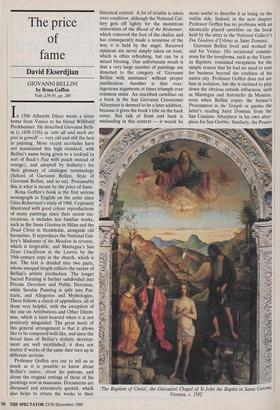The price of fame
David Ekserdjian
GIOVANNI BELLINI by Rona Goffen Yale, £39.95, pp. 288 In 1506 Albrecht Diirer wrote a letter home from Venice to his friend Willibald Pirckheimer. He described Giovanni Belli- ni (c.1430-1516) as `sehr alt and noch der pest in gemoll' — very old and still the best in painting. More recent accolades have not maintained this high standard, with Bellini's name being given to a cocktail (a sort of Buck's Fizz with peach instead of orange), and adopted by Sotheby's for their glossary of catalogue terminology (School of Giovanni Bellini, Style of Giovanni Bellini, and so on). Presumably this is what is meant by the price of fame.
Rona Goffen's book is the first serious monograph in English on the artist since Giles Robertson's study of 1968. Copiously illustrated with good colour reproductions of many paintings since their recent res- torations, it includes less familiar works, such as the Santa Giustina in Milan and the Dead Christ in Stockholm, alongside old favourites. It reproduces the National Gal- lery's Madonna of the Meadow in reverse, which is forgivable, and Mantegna's San Zeno Crucifixion in the Louvre by the 19th-century copy in the church, which is not. The text is divided into two parts, whose unequal length reflects the nature of Bellini's artistic production. The longer Sacred Painting is further subdivided into Private Devotion and Public Devotion, while Secular Painting is split into Por- traits, and Allegories and Mythologies. There follows a clutch of appendices, all of them very helpful, with the exception of the one on Attributions and Other Dilem- mas, which is faint-hearted when it is not positively misguided. The great merit of this general arrangement is that it allows like to be compared with like, and since the broad lines of Bellini's stylistic develop- ment are well established, it does not matter if works of the same date turn up in different sections.
Professor Goffen sets out to tell us as much as it is possible to know about Bellini's career, about his patrons, and about the original settings of those of his paintings now in museums. Documents are discussed and extensively quoted, which also helps to return the works to their historical context. A lot of trouble is taken over condition, although the National Gal- lery gets off lightly for the monstrous restoration of the Blood of the Redeemer, which removed the foot of the chalice and has consequently made a nonsense of the way it is held by the angel. Received opinions are never simply taken on trust, which is often refreshing, but can be a mixed blessing. One unfortunate result is that a very large number of paintings are demoted to the category of 'Giovanni Bellini with assistance' without proper justification. Another is that over- ingenious arguments at times triumph over common sense. An inscribed cartellino on a book in the San Giovanni Crisostomo Altarpiece is deemed to be a later addition, because it gives the book's title on the back cover. But talk of front and back is misleading in this context — it would be more useful to describe it as being on the visible side. Indeed, in the next chapter Professor Goffen has no problems with an identically placed cartellino on the book held by the sitter in the National Gallery's Fra Teodoro d'Urbino as Saint Dominic.
Giovanni Bellini lived and worked in and for Venice. His occasional commis- sions for the terraferma, such as the Vicen- za Baptism, remained exceptions for the simple reason that he had no need to tout for business beyond the confines of his native city. Professor Goffen does not see him in isolation, but she is inclined to play down the obvious outside influences, such as Mantegna and Antonello da Messina, even when Bellini copies the former's Presentation in the Temple or quotes the latter's reading Saint Dominic from the San Cassiano Altarpiece in his own altar- piece for San Giobbe. Similarly, the Pesaro `The Baptism of Christ', the Garzadori Chapel of St John the Baptist in Santa Corona, Vicenza, c. 1502 Coronation of the Virgin is considered without reference to Marco Zoppo's altar- piece of 1471 for the same church, which dearly determined its scale and format.
At the end of the day, however, these are mere details. The major disappoint- ment of this book concerns the quality of the writing. Giovanni Bellini's emotional intensity, his evocations of light and land- scape mean that he is one of the most immediately appealing of renaissance artists, but that does not make it any easier to bring his genius to life. It would be hard not to know more about Bellini after reading this book, but it is still to Giles Robertson — and even Roger Fry — that one will have to turn to love him more.











































































































 Previous page
Previous page